![A transport of Jewish prisoners marches through the snow from the Bauschovitz train station to Theresienstadt. [LCID: 69720]](https://encyclopedia.ushmm.org/images/large/781755a6-1ba5-4d8e-8b2b-9f25bdf3687f.jpg)
Browse an alphabetical list of photographs. These historical images portray people, places, and events before, during, and after World War II and the Holocaust.
<< Previous | Displaying results 1-25 of 79 for "Photo" | Next >>
An early view of the Dachau concentration camp. Columns of prisoners are visible behind the barbed wire. Dachau, Germany, May 24, 1933.
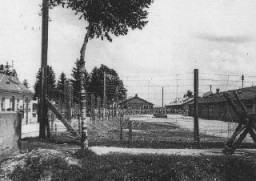
Units of a German armored division on the eastern front in February 1944. Soviet forces, largely on the offensive since the battle of Stalingrad, pushed German troops to the borders of East Prussia by the end of 1944. Soviet Union, February 1944.
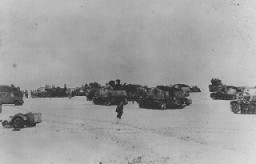
Barracks in the Ebelsberg camp for Jewish displaced persons. Ebelsberg, Austria, July 1947.
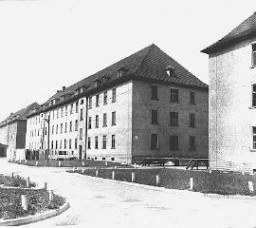
Eduard, Elisabeth, and Alexander Hornemann. The boys, victims of tuberculosis medical experiments at Neuengamme concentration camp, were murdered shortly before liberation. Elisabeth died of typhus in Auschwitz. The Netherlands, prewar.
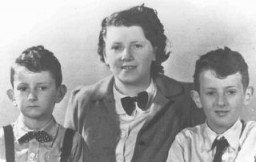
Defendant Adolf Eichmann stands as he is sentenced to death by the court. The execution of Eichmann remains the only time the State of Israel has enacted a death sentence. Jerusalem, Israel, December 15, 1961.
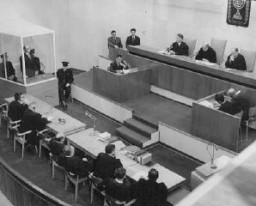
While on a tour of the newly liberated concentration camp, General Dwight Eisenhower and other high-ranking US Army officers view the bodies of prisoners who were killed during the evacuation of Ohrdruf. Ohrdruf, Germany April 12, 1945.
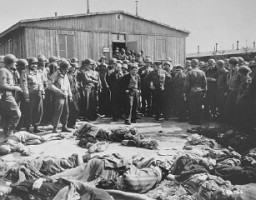
Generals Dwight D. Eisenhower and George S. Patton discuss Allied military operations in North Africa. Djebel Kouif, Algeria, March 16, 1943.
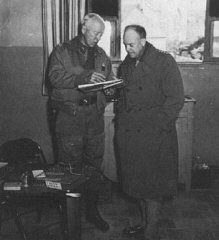
US General Dwight D. Eisenhower and General Troy Middleton, commanding general of the XVIII Corps, Third US Army, tour the newly liberated Ohrdruf concentration camp. Ohrdruf, Germany, April 12, 1945.
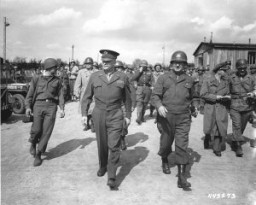
During an official tour of the newly liberated Ohrdruf concentration camp, an Austrian Jewish survivor describes to General Dwight Eisenhower and the members of his entourage the use of the gallows in the camp. Among those pictured is Jules Grad, correspondent for the US Army newspaper Stars and Stripes (on the right). Ohrdruf, Germany, April 12, 1945.
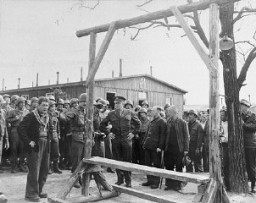
General Dwight D. Eisenhower (third from left) views the charred remains of inmates of the Ohrdruf camp. Ohrdruf, Germany, April 12, 1945.
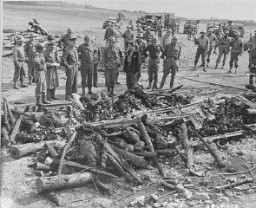
General Dwight D. Eisenhower (center, right) views the corpses of victims of the Ohrdruf camp. Germany, April 12, 1945.
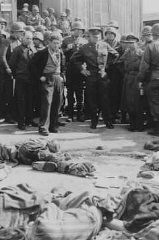
Best friends Ejanga Egiomue (left) and Magdalene Garber (right) on an outing in Berlin, Germany during World War II (likely 1941-1942). Magdalene stayed in Germany, but Ejanga fled to Denmark in 1944. Both women survived the war and stayed in contact with each other, exchanging letters and correspondence well into the 1990s.Magdalene (“Leni”) Garber was born in January, 1919 in Germany. Her parents were Joseph Garber, a Togolese man, and Johanna Maychrzak, a white German woman. Magdalene grew up in…
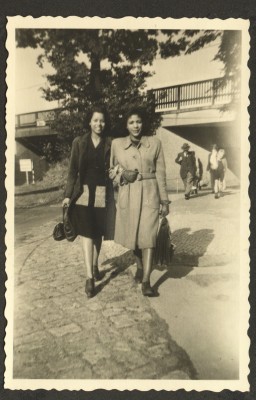
An elderly Jewish woman wears the compulsory yellow badge in the Riga ghetto. Latvia, between 1941 and 1944.
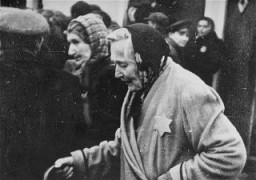
Election officers count votes late into the night after the second round of the 2006 presidential and provincial elections in Bunia, Ituri, Democratic Republic of the Congo.

Poster: "Greater Germany: Yes on 10 April" (1938). This election poster emphasizes the message of jumping on the Nazi political bandwagon, as represented by the hands raised in a unified Nazi salute. Nazi propaganda frequently stressed the power of a mass movement to propel the country forward, subtly underscored by the upward angle of the hands. This poster typifies the propaganda strategy of using simple confident slogans, with bold graphics often using the characteristic Nazi colors of red, black, and…
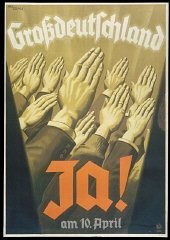
Eliahu Dobkin of the Jewish Agency (left) and Henrietta Szold, founder of the Hadassah Women's Zionist Organization (second from left), await the arrival of the "Tehran Children." Atlit, Palestine, February 18, 1943.
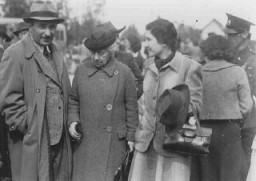
Elie Wiesel became Founding Chairman of the United States Holocaust Memorial Council in 1980. Here, he speaks at a ceremony held during the Tribute to Holocaust Survivors, one of the Museum's tenth anniversary events. Flags of US Army liberating divisions form the backdrop to the ceremony. Washington, DC, November 2003.
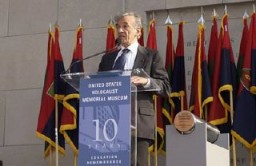
Elie Wiesel with his wife Marion and President Ion Iliescu in Sighet following the presentation of the Final Report of the International Commission on the Holocaust in Romania.Learn more about Romania facing its past.
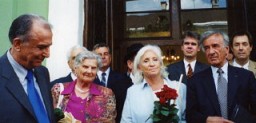
Elie Wiesel speaks at the Faith in Humankind conference, held before the opening of the United States Holocaust Memorial Museum, on September 18–19, 1984, in Washington, DC.
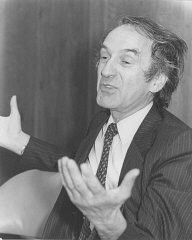
Elie Wiesel speaks at the Days of Remembrance ceremony, Washington, DC, 2001.
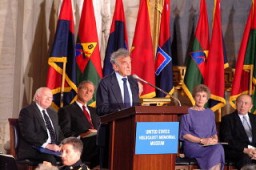
Elie Wiesel speaks at the Days of Remembrance ceremony, Washington, DC, 2002.
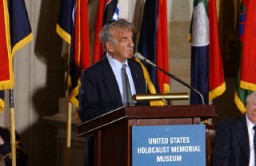
Elie Wiesel speaks at the Faith in Humankind conference, held several years before the opening of the United States Holocaust Memorial Museum. September 18–19, 1984, in Washington, DC.
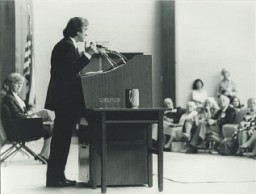
Elie Wiesel (right) with his wife and son during the Faith in Humankind conference, held several years before the opening of the United States Holocaust Memorial Museum. September 18–19, 1984, in Washington, DC.
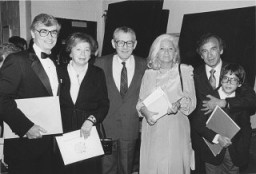
Elie Wiesel with President Ion Iliescu in Sighet following the presentation of the Final Report of the International Commission on the Holocaust in Romania.
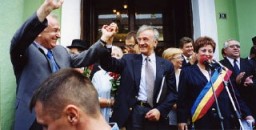
Elisabeth, Hans Werner, and Paul Gerhard Kusserow. Because they were the children of Jehovah's Witnesses, all three were forcibly removed from school on March 7, 1939, and kept separated from their family, which was accused of spiritual and moral neglect, until their liberation in April 1945. This photograph was taken at the Kusserow home in Bad Lippspringe, 1936-1939.
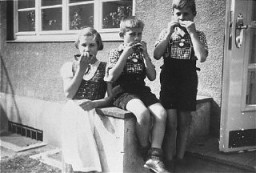
We would like to thank Crown Family Philanthropies, Abe and Ida Cooper Foundation, the Claims Conference, EVZ, and BMF for supporting the ongoing work to create content and resources for the Holocaust Encyclopedia. View the list of donor acknowledgement.